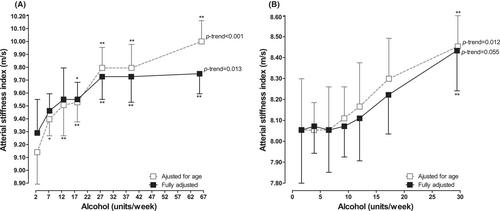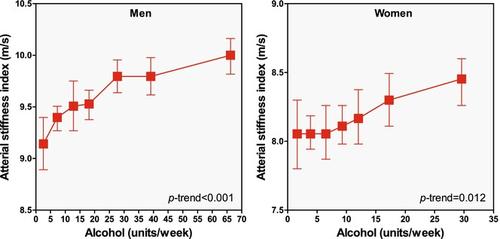The association between arterial stiffness and alcohol consumption is still controversial. We investigated this relationship by performing continuous analysis in men drinking only beer/cider, and women drinking only red wine.
This cross-sectional study involved participants aged 40–69 years consisting of 9029 men who drank only beer/cider, and 6989 women drinking only red wine. Alcohol consumption was captured by self-reported questionnaire and reported as units per week, where one unit is equal 10 mL pure ethanol. Arterial stiffness index (ASI) was estimated using photoplethysmography.
In men consuming a mean 17.8 (5th and 95th percentiles, 2.6–76.7) units/week, ASI increased by heptiles (sevenths) of alcohol captured from beer/cider consumption and after adjusting for age (9.14, 9.40, 9.51, 9.53, 9.80, 9.80, 10.00 m/s; p-trend < 0.001) and after full adjustment (9.29, 9.46. 9.55, 9.55, 9.73, 9.73, 9.75 m/s; p-trend = 0.013). Similarly, in women consuming a mean 8.1 (1.6–29.3) units/week, ASI increased by heptiles of alcohol captured from red wine consumption and after adjusting for age (8.05, 8.05, 8.05, 8.11, 8.17, 8.30, 8.45 m/s; p-trend = 0.012) and borderline significant after full adjustment (8.05, 8.07, 8.05, 8.07, 8.11, 8.22, 8.43 m/s; p-trend = 0.055). These associations were confirmed in multivariable-adjusted regression analysis in all men, men younger and older than 50 years, and when consuming more than 14 units per week. Similarly, these associations were confirmed in all women, women older than 50 years, and in those consuming more than 14 units per week.
Positive linear relationships exist between arterial stiffness and alcohol, irrespective of whether captured from beer/cider consumption in men or red wine consumption in women. No evidence existed to support the notion that our arteries benefit from any level of alcohol consumption.



